牛津译林版八年级上册8AUnit4Task教学反思
- 格式:docx
- 大小:13.25 KB
- 文档页数:2

盐城市初中英语精英教师培训班学员教课方案作品Unit 4 Do it yourself教课方案盐城市盐阜中学董爱红一、教课内容剖析教课内容牛津英语 8A unit4 Grammar教课对象教课项目单词、短语cut sentence on the other side和句型begin your work without reading them等语法发出指令、使用should 和 had better教课方法学生中心教课法,多媒体教课教课目的语言知识掌握发出指令,should和had better等句型语言技术概括总结技术语言运用运用发出指令, should 和 had better 等句型感情态度认识 DIY 的利处,倡议 DIY 的生活方式教课要点掌握发出指令, should 和 had better 等句型教课难点运用发出指令, should 和 had better 等句型运用任务运用发出指令, should 和 had better 等句型来讨论怎样预防腮腺炎二、讲堂教课过程时间教课教师活动步骤2Warm A game: Do opposite actions. minutes up For example: Stand up, Sit down, before Don ’tturn left, Don ’tturn right class3Prese Present some sentences from the text: minutes ntatio Read them first. Do it yourself. Stop n it.6Practi Ask: How to make a pumpkin lantern minutes ce4Practi Help students complete: How to make minutes ce cards on P47 and check the answers. 6Practi Ask: what should we do in the minutes ce library? What shouldn ’twe do in thelibrary?4Prese Present some sentences from the text:学生活动Students do oppositeactionsRead and find out therule: how to give instructions.Discuss in group, make itand say.Complete: How tomake cards on P47.Discuss in groups andsay.Read and find out the教课目的激活学生已有知识并调换学生兴趣激活学生已有知识并概括总结提高使用刚刚学习过的语法达成练习激活学生已有知识激活学盐城市初中英语精英教师培训班学员教课方案作品minutes ntatio What should we do? You ’d better get rule: how to use should n some tools.and had better.6Prese Ask: How to be a good student?Discuss in groups and minutes ntatio sayn4Practi Help students complete: DIY advice Complete : DIY advice minutes ce and check the answers.6Prese Ask:How to prevent Mumps( 腮腺Discuss in groups and minutes ntatio炎 )sayn5Exerci Help the students complete the Complete the exercise. minutes se exercise and check the answers.English people like DIY . A lot ofpeople spend their holiday makingtheir homes more b______1______.If there is anything that needsrepairing or decorating around theirhomes, such as p_____2_____thewalls or putting in a new shower, theywill do the jobs themselves. Theys_____3______ DIY experience withtheir friends. More and more peopleshow an i______4_____ in DIY .Sometimes people also DIY in orderto s_____5_____ money. They aretrying to find ways to make theirhouse better when they can’t affordthe c______6_____. So,it ’s notsurprising that DIY is very popular.DIY can be different.People oftenfind it more e______7______ to builda piece of furniture because they can ’tunderstand the instructions well.Sometimes the instructions are simpleand clear,but the furniturei______8_____ is difficult to build.DIY can also be d______9_____.People should learn much about DIYwork before doing it.U______10_____, many people don ’tcare about that. So they may be in 生已有知识并概括总结提高使用刚刚学习过的语法达成练习拓展思维当堂检测盐城市初中英语精英教师培训班学员教课方案作品danger.1Home Say: Finish some exercises.minute work三、教课反省教课反省。
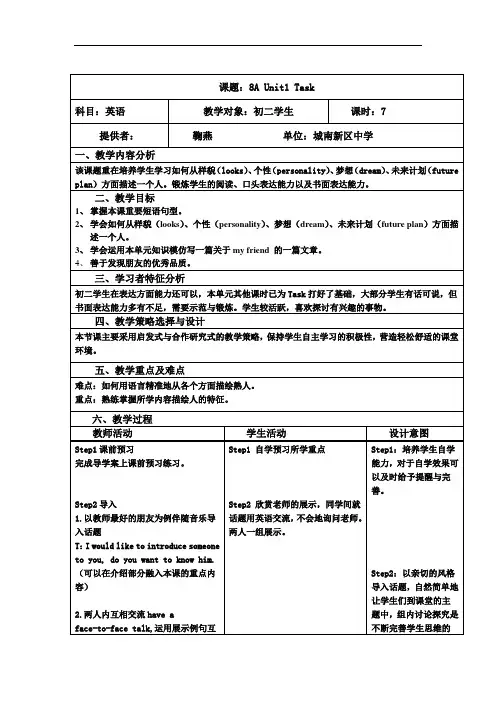
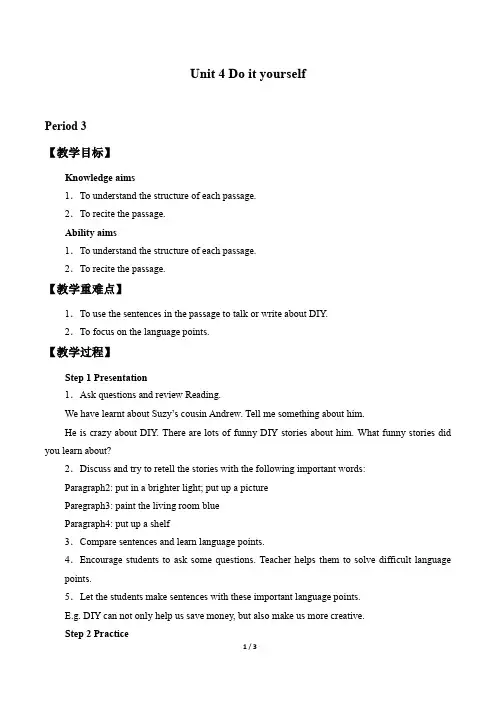
Unit 4 Do it yourselfPeriod 3【教学目标】Knowledge aims1.To understand the structure of each passage.2.To recite the passage.Ability aims1.To understand the structure of each passage.2.To recite the passage.【教学重难点】1.To use the sentences in the passage to talk or write about DIY.2.To focus on the language points.【教学过程】Step 1 Presentation1.Ask questions and review Reading.We have learnt about Suzy’s cousin Andrew. Tell me something about him.He is crazy about DIY. There are lots of funny DIY stories about him. What funny stories did you learn about?2.Discuss and try to retell the stories with the following important words:Paragraph2: put in a brighter light; put up a pictureParegraph3: paint the living room blueParagraph4: put up a shelf3.Compare sentences and learn language points.4.Encourage students to ask some questions. Teacher helps them to solve difficult language points.5.Let the students make sentences with these important language points.E.g. DIY can not only help us save money, but also make us more creative.Step 2 Practice1.Complete B4Open your books and turn, please. Suzy is telling Kitty about her cousin’s DIY. Help her complete the conversation.2.Check answers.Let’s read Suzy and Kitty’s conversation. Girls will play the role of Suzy and boys will play the role of Kitty. Then change roles.3.Let’s read the conversation together.4.Please make dialogues about DIY with your own words. Here are some questions that can help you complete the dialogues:(1)what do you like to do?(2)what do you often help your parents do?(3)do you think it’s good to help with the housework?(4)Are you good at DIY?(5)what do you think is the best thing about DIY? Why?(6)Do you have any problems with DIY?(7)who can you ask for DIY advice?5.Work in pairs to practice the dialogue.6.Show time.Things learnt through practice are more effective than the ones learnt from books. Try to do some DIY work and you can learn what you never expected.Step 3 consolidationPlease complete these sentences.(1)It was_____________________(一个很大的错误)to leave my umbrella at home.(2)The meeting room__________________(充满了)thick smoke an hour ago.(3)Please put the book_________________(架子上)。

Unit4Doityourself课题Unit4Doityourself---Welcometotheunit课时第一课时执教时间复备人教学目标1.知识目标:学习词汇:Instruction,hadbetter,tool,brush,glue,rope,scissors,tape,DIY,exactly,standfor,repair,decorate,insteadof,rose学习词组:hadbetterdosth.,Noproblem,doityourself,standfor,insteadof,makesomepaperroses学习句子:—What’sDIYexactly,Suzy?—Itstandsfor“do-it-yourself”.WhenyoudoDIY,youmake,repairordecoratethingsyourse lfinsteadofpayingsomeonetodoit.She’sgoingtomakesomepaperroses.Sheneedssomepaper ,glueandapairofscissors.You'dbettergetsometools.2.技能目标:a.TolearntounderstandtheconversationbetweenHoboan任务二:Presentation Showsomepicturestotalkabouthowtodoity ourself.T:EddieandHobowanttodosomethingbythem selves.Ask:Howcanwedoityourself? DIYasweater:如果你觉得自己的sweater 太过单调,可以试着在上面画一幅画。
过程Step3:课堂导学与互动任务一:Freetalk1.DoyoulikeDIY?2.HaveyouevertriedDIY?Whatisit?3.DoyouwanttotakeacourseinDIY?任务二:ListenandfinishPartB1onPage45. Matchthewordsontheleftwiththemeaning sontheright.任务三:FinishPartB2onPage45.Suzy’scousinAndrewiscrazyaboutDIY,b utheisnotverygoodatit.Liste ntoSuzy’sarticleandmatchthejobshedidwiththep roblemshecaused.任务四:ReadandfinishPartB3onPage46. 任务五:WatchandfinishPartB4onPage46. Step4:总结提升Workinseveralgroups. Makeupsentenceswithyourpartnersw iththephrasesabove.Speakthemouttous.Let’sseewhichgroupisthemost active.学法指导查阅资料与练习相结合。

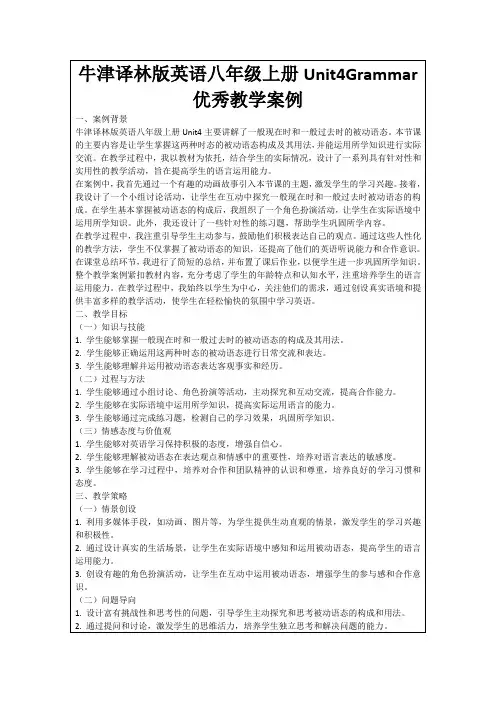

牛津译林版英语八年级上册Unit4_study_skills教学设计一. 教材分析牛津译林版英语八年级上册Unit4的主题是“study skills”,主要让学生掌握如何有效地学习。
本节课将介绍一些学习技巧,如如何制定学习计划、如何集中注意力等。
教材中包含一些任务和活动,旨在帮助学生提高他们的学习技能。
二. 学情分析八年级的学生已经具备了一定的英语基础,对于学习技巧也有一定的了解。
但他们在实际应用中可能会遇到一些问题,例如难以制定合理的学习计划,容易分心等。
因此,在教学过程中,需要引导学生认识到这些问题,并帮助他们找到解决问题的方法。
三. 教学目标1.知识目标:让学生掌握如何制定学习计划、如何集中注意力等学习技巧。
2.能力目标:通过各种活动,提高学生的听说读写能力。
3.情感目标:培养学生积极主动学习的态度,养成良好的学习习惯。
四. 教学重难点1.重点:让学生掌握学习技巧,如制定学习计划、集中注意力等。
2.难点:如何引导学生将这些学习技巧应用到实际学习中。
五. 教学方法1.任务型教学法:通过完成各种任务,让学生在实践中学习。
2.合作学习法:鼓励学生互相合作,共同解决问题。
3.情境教学法:创设真实的学习情境,让学生更好地理解和学习。
六. 教学准备1.教师准备:准备好相关的教学材料,如PPT、任务单等。
2.学生准备:提前让学生预习教材,了解本节课的主题。
七. 教学过程1.导入(5分钟)教师通过提问方式引导学生谈论学习技巧,激发学生的学习兴趣。
例如:“你们觉得学习技巧重要吗?为什么?”2.呈现(10分钟)教师通过PPT展示本节课的主题“study skills”,并简要介绍本节课将学习的一些学习技巧。
3.操练(15分钟)教师学生进行小组讨论,让学生分享自己的学习技巧。
每个小组选出一个代表进行汇报,其他小组成员可以进行补充和评价。
4.巩固(10分钟)教师设计一些练习题,让学生通过完成练习来巩固所学内容。
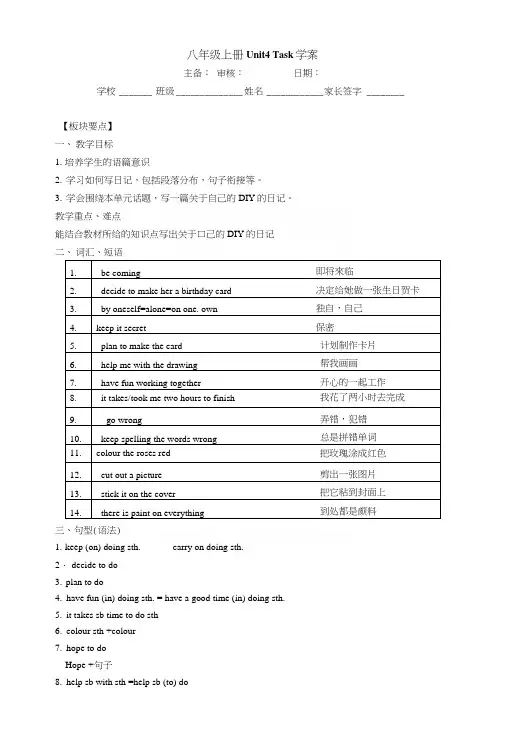
主备:审核:日期:学校_______ 班级______________ 姓名____________ 家长签字 ________【板块要点】一、教学目标1.培养学生的语篇意识2.学习如何写日记,包括段落分布,句子衔接等。
3.学会围绕本单元话题,写一篇关于自己的DIY的日记。
教学重点、难点能结合教材所给的知识点写出关于口己的DIY的日记二、词汇、短语1. be coming 即将來临2. decide to make her a birthday card 决定给她做一张生日贺卡3. by oneself=alone=on one. own 独自,自己4. keep it secret 保密5. plan to make the card 计划制作卡片6. help me with the drawing 帮我画画7. have fun working together 开心的一起工作8. it takes/took me two hours to finish 我花了两小时去完成9. go wrong 弄错,犯错10. keep spelling the words wrong 总是拼错单词11. colour the roses red 把玫瑰涂成红色12. cut out a picture 剪出一张图片13. stick it on the cover 把它粘到封面上14. there is paint on everything 到处都是颜料三、句型(语法)1.keep (on) doing sth. carry on doing sth.2・ decide to do3.plan to do4.have fun (in) doing sth. = have a good time (in) doing sth.5.it takes sb time to do sth6.colour sth +colour7.hope to doHope +句子8.help sb with sth =help sb (to) do主备:审核:日期:2018-08-01学校_______ 班级______________ 姓名____________ 家长签字_________【课前导学】一、词组翻译。
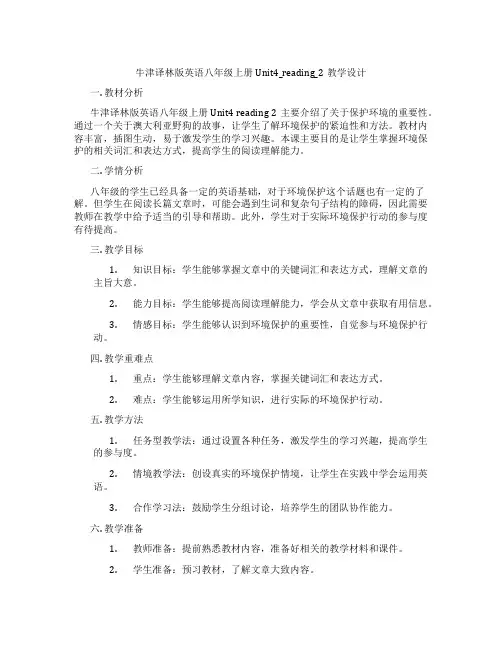
牛津译林版英语八年级上册Unit4_reading_2教学设计一. 教材分析牛津译林版英语八年级上册Unit4 reading 2主要介绍了关于保护环境的重要性。
通过一个关于澳大利亚野狗的故事,让学生了解环境保护的紧迫性和方法。
教材内容丰富,插图生动,易于激发学生的学习兴趣。
本课主要目的是让学生掌握环境保护的相关词汇和表达方式,提高学生的阅读理解能力。
二. 学情分析八年级的学生已经具备一定的英语基础,对于环境保护这个话题也有一定的了解。
但学生在阅读长篇文章时,可能会遇到生词和复杂句子结构的障碍,因此需要教师在教学中给予适当的引导和帮助。
此外,学生对于实际环境保护行动的参与度有待提高。
三. 教学目标1.知识目标:学生能够掌握文章中的关键词汇和表达方式,理解文章的主旨大意。
2.能力目标:学生能够提高阅读理解能力,学会从文章中获取有用信息。
3.情感目标:学生能够认识到环境保护的重要性,自觉参与环境保护行动。
四. 教学重难点1.重点:学生能够理解文章内容,掌握关键词汇和表达方式。
2.难点:学生能够运用所学知识,进行实际的环境保护行动。
五. 教学方法1.任务型教学法:通过设置各种任务,激发学生的学习兴趣,提高学生的参与度。
2.情境教学法:创设真实的环境保护情境,让学生在实践中学会运用英语。
3.合作学习法:鼓励学生分组讨论,培养学生的团队协作能力。
六. 教学准备1.教师准备:提前熟悉教材内容,准备好相关的教学材料和课件。
2.学生准备:预习教材,了解文章大致内容。
七. 教学过程1.导入(5分钟)利用图片或视频展示澳大利亚野狗的形象,引导学生关注环境保护话题。
教师提问:“你们认为环境保护重要吗?为什么?”让学生发表自己的看法。
2.呈现(10分钟)教师简要介绍文章内容,然后让学生阅读文章,注意遇到生词和复杂句子结构时,可以先略过,整体理解文章大意。
3.操练(15分钟)学生分角色朗读文章,注意模仿语音语调。
教师提问:“你们在阅读过程中遇到了哪些生词和困难?”引导学生分享学习心得。
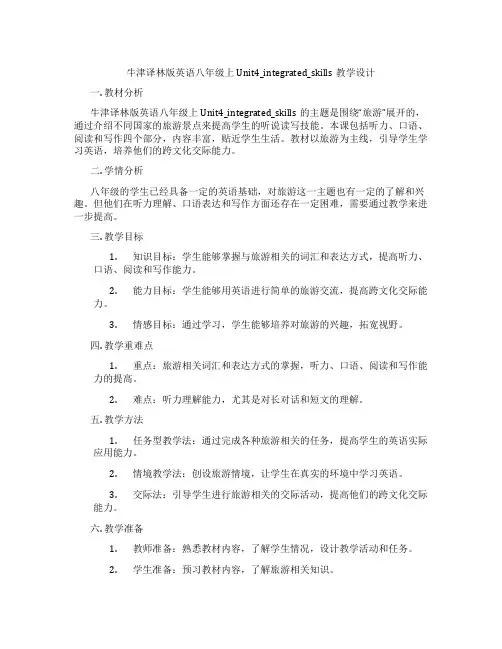
牛津译林版英语八年级上Unit4_integrated_skills教学设计一. 教材分析牛津译林版英语八年级上Unit4_integrated_skills的主题是围绕“旅游”展开的,通过介绍不同国家的旅游景点来提高学生的听说读写技能。
本课包括听力、口语、阅读和写作四个部分,内容丰富,贴近学生生活。
教材以旅游为主线,引导学生学习英语,培养他们的跨文化交际能力。
二. 学情分析八年级的学生已经具备一定的英语基础,对旅游这一主题也有一定的了解和兴趣。
但他们在听力理解、口语表达和写作方面还存在一定困难,需要通过教学来进一步提高。
三. 教学目标1.知识目标:学生能够掌握与旅游相关的词汇和表达方式,提高听力、口语、阅读和写作能力。
2.能力目标:学生能够用英语进行简单的旅游交流,提高跨文化交际能力。
3.情感目标:通过学习,学生能够培养对旅游的兴趣,拓宽视野。
四. 教学重难点1.重点:旅游相关词汇和表达方式的掌握,听力、口语、阅读和写作能力的提高。
2.难点:听力理解能力,尤其是对长对话和短文的理解。
五. 教学方法1.任务型教学法:通过完成各种旅游相关的任务,提高学生的英语实际应用能力。
2.情境教学法:创设旅游情境,让学生在真实的环境中学习英语。
3.交际法:引导学生进行旅游相关的交际活动,提高他们的跨文化交际能力。
六. 教学准备1.教师准备:熟悉教材内容,了解学生情况,设计教学活动和任务。
2.学生准备:预习教材内容,了解旅游相关知识。
3.教学资源:多媒体教学设备,旅游图片、视频等资源。
七. 教学过程1.导入(5分钟)教师通过展示旅游图片或视频,引导学生谈论旅游话题,激发学生兴趣。
2.呈现(10分钟)教师展示教材中的听力材料,让学生听懂并理解对话内容。
过程中,教师可引导学生预测对话内容,提高他们的听力预测能力。
3.操练(10分钟)教师学生进行听力练习,如填空、选择等,检查学生对听力材料的理解程度。
同时,教师可引导学生进行角色扮演,模拟旅游场景,提高他们的口语表达能力。
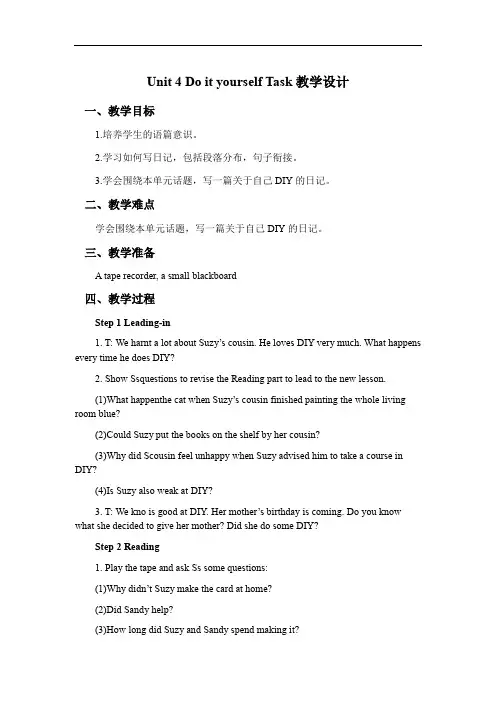
Unit 4 Do it yourself Task教学设计一、教学目标1.培养学生的语篇意识。
2.学习如何写日记,包括段落分布,句子衔接。
3.学会围绕本单元话题,写一篇关于自己DIY的日记。
二、教学难点学会围绕本单元话题,写一篇关于自己DIY的日记。
三、教学准备A tape recorder, a small blackboard四、教学过程Step 1 Leading-in1. T: We harnt a lot about Suzy’s cousin. He loves DIY very much. What happens every time he does DIY?2. Show Ssquestions to revise the Reading part to lead to the new lesson.(1)What happenthe cat when Suzy’s cousin finished painting the whole living room blue?(2)Could Suzy put the books on the shelf by her cousin?(3)Why did Scousin feel unhappy when Suzy advised him to take a course in DIY?(4)Is Suzy also weak at DIY?3. T: We kno is good at DIY. Her mother’s birthday is coming. Do you know what she decided to give her mother? Did she do some DIY?Step 2 Reading1. Play the tape and ask Ss some questions:(1)Why didn’t Suzy make the card at home?(2)Did Sandy help?(3)How long did Suzy and Sandy spend making it?(4)What mistakes did Suzy keep making when working on it?(5)What colour did she use for the roses?(6)Did they make a mess in the house?2. Play the tain and ask Ss to repeat after the tape sentence by sentence.3. Askstudents to read the diary entry paragraph by paragraph. Then discuss what each paragraph is about.Para 1: The reason why Suzy made a birthday card.Para 2: How she made the card.Para 3: What happened in the end.Para 4: Suzy’s hope.Step 3 Writing1. Show Ss some useful expressions.2. Get Ss to wheir own diary entry about one of the DIY jobs they did.3. Ask some students to read their own articles.Step 4 Homework1. Remember the new words and useful expressions.2. Recite the diary entry on page52.。
牛津译林版八年级上英语Unit4集体备课表格式教案璇?棰?8A Unit 4 Welcome to this unit璇惧瀷New鏁?甯?鍐?瀹??璇?棰?8A Unit 4 Reading (1) 璇惧瀷NewTo learn about vocabulary about DIY.To understand the article and finish relative exercise. To cultivate the sense of DIY.鏁?甯?鍐?瀹??璇?棰?8A Unit 4 Reading (2)璇惧瀷New鏁?甯?鍐?瀹??璇?棰?8A Unit 4 Grammar A 璇惧瀷New鏁?甯?鍐?瀹?? 璇?棰?8A Unit 4 Grammar B璇惧瀷New鏁?甯?鍐?瀹?Step 1 Presentation1. Review Reading to introduce the usage of 鈥渟hould鈥?T: Suzy doesn鈥檛think her cousin knows much about DIY either. What did she advise him to do?T: What do you think she said to him about this?Write this sentence on Bb and mark the word should in red.2. T锛欴o you think we can use had better instead of should in this sentence?Write 鈥淵ou had better take a course in DIY.鈥?Ask ss to think and understand the meaning of the two sentences.3. Present more sentences, encourage ss to sum up the rule: Here are some more sentences. Can you work out when to use should and had better?锛?锛塗o keep fit, you should /had better have a healthy diet.锛?锛塝ou should not /had better not leave litter.锛?锛塈t鈥檚going to rain. You should/had better take an umbrella.4.Work out the rule with ss: We use should and had better when giving advice and telling people what we think is the best or right thing to do. The tone of had better is strong than should.5. Please open your books and turn to page 48. Let鈥檚read the sentencestogether.Step 2 Practice1. T: Suzy is giving DIY advice to her classmates. Can you help her make sentences with should(not) and had better(not)?Have ss do exercise on page 48, and then read and check answers together.2. T: You鈥檙e giving advice to your friends. Rewrite the following sentences using should(not) and had better(not):(1) It鈥檚time for class. Put your comic books away.(You should/had better put your comic books away.)(2锛塝our English is not good enough. Read more to improve it.(You should/had better read more to improve it)(3)Turn your mobile phone off in class.(You should/had better turn your mobile phone off in class.)(4) Don鈥檛make the mistake again.(You should/had better not make the mistake again.)3.T: Boys and girls ,you have learnt how to give advice. I have a problem and I need your help. I can鈥檛sleep well at night and I feel tired during the day. Can you give me some advice?Encourage ss to give advice:You should drink a glass of milk before going to bed./ You should not watch TV just before going to sleep./You had better do some reading before you go to sleep./鈥?4.T: Work in pairs. Talk about your problems and try to give useful advice.Homework1.Preview Grammar2.Finish the relative exercise.?璇?棰?8A Unit 4 Integrated skills 璇惧瀷New鏁?甯?鍐?瀹?A .How to make a fruit saladStep 1 Presentation1. Communicate with ss to lead in new lessons: What did you have forbreakfast/lunch today? What food do you like best? Do you have a healthy diet? Can you cook dinner on your own?2. Present the picture of salad and ask: Look at the picture .This is my favorite food. What is it? Yes, it鈥檚a salad.Write salad on Bb and teach the new words.T: Salad is healthy. Do you like it? Do you think it鈥檚easy to make a salad? Can you make a salad?3. T: What do you need when making a salad?Write spoon and cream on Bb, teach the new words and explain.Step 2 Listening1. T: Open your books and turn to page 49. Look at the pictures in Part A1.T: When we make a salad, we need some tools and we can add anything we like. Canyou name the things in the pictures锛?Write grape and strawberry.2. T: Any and Suzy are making a fruit salad. They鈥檙e talking about what they need. Listen to their conversation and tick the things they need.Play the tape.3. T: Any volunteers? Have a try. The rest of you can check the answers together.If they can鈥檛obtain correct information, play the tape again, pause if necessary.4. T: Amy is making some notes of how to make a fruit salad. Read her notes and put the sentences in the correct order.Play the tape again, ask ss to finish Part A2 on page 49.5. Ask ss to read together and check answers.Step 3 Listening1. T: Amy wants to make a fruit salad. She鈥檚asking Suzy for some tips. Please listen to their conversation and help Amy complete her notes in Part A3 on page 50.2. Ask ss to read together and check answers.B.Speak upStep 4 Activities1. Have a free talk.What do you often have for lunch?Do you like sandwiches for lunch?Sandy and her mum are talking about what to eat for lunch.2. Play the tape.Are sandwiches quick and easy to make ?What do they put on the bread?Do they just need one piece of bread?3. Play the tape and ask ss to repeat after the tape.4. Work in pairs: Work in pairs. It鈥檚your turn to make similar dialogues. Talk about what you can make for lunch. You can use Sandy and her mother鈥檚conversation as a model.Homework1. Memorize words, phrases and sentences.2. Recite Speak up.3. Preview Study skills.?璇?棰?8A Unit 4 Study skills璇惧瀷New鏁?甯?鍐?瀹?Step 1 Presentation1.Show some words on the blackboard old-young easy-hard tall-shortrude/impolite-polite happy-unhappy kind-unkindNow锛寃e know they are prefixes.2.PresentationSay: With some adjectives, we can change the meaning by adding a prefix. Adding the prefixes 鈥渄is鈥? 鈥渋m鈥?鈥渋n鈥?or 鈥渦n鈥?to an adjective will express the opposite meaning of the word. These prefixes mean 鈥渘ot鈥?or 鈥渢he opposite of鈥?e.g. Trainers are comfortable to wear.But small ones are uncomfortable.If someone shows good manners to others, he is a polite person.If someone does not show good manners to others, he is impolite.Step 2 Practice1.Tell the students that 鈥渦n-鈥漣s not the only prefix. There are more prefixes like this. Invite the students to open their book and ask them to match the words on the left with their opposites on the right.1.certain鈥晆ncertain2.important鈥晆nimportant 鈥?2. Show some sentences and fill in the blanks with prefixes.Zhalong is a protected area. It isn鈥檛allowed to hunt or fish there. It is incorrect to kill wild animals. (correct)These trainers are comfortable to wear. But those are uncomfortable. (not comfortable).If someone shows good manners to others, he is a polite person. If someone doesn鈥檛show good manners to others, he is impolite. (not polite )3.Try to pronounce the underlined words銆?1.The boy in this picture is Jake .He often plays with his cat after school.2.Tennis is Lily鈥檚favorite sport .She likes playing tennis with her father.3.What does she look like?She looks slim.4.The girl has a lot of bags in her hand.She is shopping.5.I am a student .I go to school by bus every day.Step 3 Group work鐢ㄥ惁瀹氬墠缂€鐨勫舰瀹硅瘝閫犲彞銆?(1)Water is very important to us.(2) This chair is too small.锛?锛塈have never seen such heavy snow here.锛?锛塗he restaurant is quite near here.锛?锛塈don鈥檛like him because he is rude.Step 4 ExerciseTry to finish the exercises on Page51 and check the answers. usual-unusual possible-impossiblecertain-uncertain tidy-untidy鍐欏嚭涓嬪垪璇嶇殑鍙嶄箟璇?necessary--_________important--_________happy--_________comfortable--_________ friendly--__________ common--_________welcome--__________able--_________ well--__________popular--__________ true--__________ tidy--__________?璇?棰?8A Unit 4 Task璇惧瀷New鏁?甯?鍐?瀹?Step 1 Lead in1.T: We鈥檝e learnt a lot about Suzy鈥檚cousin. He loves DIY very much. What happens every time he does DIY?2.Present more questions,(1) What happen to the cat when Suzy鈥檚finished painting the whole living room blue?(2) Could Suzy put the books on the shelf made by her cousin?(3) Why did Suzy鈥檚cousin feel unhappy when Suzy advised him to take a course in DIY?(4) Is Suzy also weak at DIY?3. T: We know Suzy is good at DIY. Her mother鈥檚birthday is coming. Do you know what he decided to give her mother? Did she do some DIY?Encourage ss to guess the possibility.Step 2 Reading1. T: Suzy made a birthday card at the weekend. Listen to her diary entry carefully and find the answers to these questions.(1) Why didn鈥檛Suzy make the card at home?(Because she wanted to keep it secret.)(2) Did Sandy help?(Yes. Sandy helped her with the drawing.)(3) How long did Suzy and Sandy spend making it?(They spent two hours making it.)(4) What mistakes did Suzy keep making when working on it?(She kept spelling the words wrong because she was too excited.)(5) What colour did she use for the roses?(She coloured them red, blue and pink.)(6) Did they make a mess in the house?(Yes. There was paint on everything.)2. Play the tape.T: Open your books and turn to page 52, please. Let鈥檚repeat after the tape sentence by sentence.3. Ask ss to read the article paragraph by paragraph and think over the content of each paragraph.4. Make ss understand the content of a diary.Para 1: The reason why Suzy made a birthday card.Para 2: How she made the card.Para 3: What happened in the end.Para 3: Suzy鈥檚hope.Step 3 Writing1. Ask ss to turn to page 53, part B.T: Write your own diary entry about one of the DIY jobs you did. Use the diary entry in Part A as a model and use the useful expressions on page 52 to help you. Look at the ideas in Part B. You can choose to write about one of them or use your own ideas.2. Check the composition.Comment on two of their articles.3. Read the sample together.Homework1. Memorize words, phrases and sentences.2. Read and recite the sample writing.精品教案设计资料3. Finish relative exercises.?。
牛津译林版八年级上册Unit 8《Natural disasters》(Task)教学设计一. 教材分析牛津译林版八年级上册Unit 8《Natural disasters》主要介绍了自然灾害,包括地震、洪水、台风等,通过学习本单元,学生可以掌握有关自然灾害的词汇和表达方式,了解自然灾害发生的原因及应对措施。
Task部分要求学生阅读一篇关于自然灾害的文章,然后进行相关练习,培养学生的阅读能力和解决问题的能力。
二. 学情分析八年级的学生已经具备了一定的英语基础,能够进行简单的阅读和交流。
但部分学生在阅读长篇文章时,可能会遇到生词和语法难题,影响阅读理解。
此外,学生对于自然灾害的了解程度不一,需要教师在教学中进行引导和补充。
三. 教学目标1.知识目标:学生能够掌握有关自然灾害的词汇和表达方式,了解自然灾害发生的原因及应对措施。
2.能力目标:学生能够阅读并理解关于自然灾害的文章,提高阅读能力;通过任务型教学,培养学生的解决问题能力。
3.情感目标:培养学生关爱生命,关注自然的意识,提高学生应对自然灾害的能力。
四. 教学重难点1.重点:学生能够掌握有关自然灾害的词汇和表达方式,阅读并理解关于自然灾害的文章。
2.难点:学生能够运用所学知识,解决实际问题,提高应对自然灾害的能力。
五. 教学方法1.任务型教学法:通过任务型教学,让学生在实践中掌握知识,提高能力。
2.情境教学法:创设情境,让学生在真实的环境中学习,提高学生的学习兴趣。
3.合作学习法:引导学生进行小组合作,培养学生的团队精神和沟通能力。
六. 教学准备1.教师准备:提前准备关于自然灾害的文章,整理相关词汇和表达方式,设计任务型练习。
2.学生准备:预习课文,了解自然灾害的基本知识,准备参与课堂活动。
七. 教学过程1.导入(5分钟)教师通过提问方式引导学生谈论自然灾害,激发学生的学习兴趣。
例如:“你们知道哪些自然灾害?它们发生的原因是什么?”2.呈现(10分钟)教师呈现关于自然灾害的文章,让学生快速阅读,了解文章大意。
662020年15期总第507期ENGLISH ON CAMPUS译林版初中英语8B Unit4 Reading1 教学与反思文/陈 楠前不久,我执教了一节校内公开课,教学内容为译林版《牛津初中英语》8B第四单元,课题为A good read,课型是阅读课第一课时。
执教结束之后颇有感想,参考同组老师的点评,我总结出以下教学反思。
教学片段与反思教学片段1:Pre-reading (1) IntroductionT: Hi, guys, recently I have been reading a novel calledGulliver’s travels, It is very interesting, and yesterday I read the part of Gulliver in Lilliput. Now I want to recommend this(2)presentationT: Now I show some pictures to you.① His ship crashed against the rocks.② The ship can’t continue moving.③ He is tired out after swimming for a long time. ④ His arms, legs and hair were tied to the ground.⑤ He saw a tiny man. The tiny man was the same size asGulliver’s little finger.⑥ Gulliver managed to break the ropes. ⑦ He lifted his left hand into the air.⑧ He saw a huge army of tiny people.教学反思1:本课的导入环节主要分为两个部分,一是通过教师口述引导学生了解本课的教学背景知识。
8A Unit 4 Period 2 Reading(1)教学目标To get Ss to grasp some new words about DIY.To read the text to understand the content and do some exercises correctly. To encourage Ss to do some DIY work.教学重、难点To read the text to understand the content and do some exercises correctly.教学准备 A tape recorder, a small blackboard课前预习Preview the new words.教学过程教学环节教师活动学生活动备注Step 1 Leading-in Step 2Pre-reading Step 3While-reading A free talk with Ss:Do you like DIY?Have you ever tried DIY? What’s it?1. Tell Ss that Suzy’s cousin Andrew likesDIY a lot. He’s crazy about DIY.Teach ‘be crazy about’2. Show Ss the picture o Page 44 and ask:What happened to Andrew?Encourage Ss to answer the question: Hetried to hit the nail with a hammer, but hehit a pipe and fill ed the room with water.He made a mistake. It was terrible.3. Get Ss to complete Part B1.4. T: Do you think Suzy’s cousin is goodat DIY?No, he isn’t. He caused a lot ofproblems when he did things himself.1. Go through the text and complete PartB2.2. Play the tape for Ss and ask them to dosome “T or F” exercises. If the sentence isfalse, ask Ss to correct it.3. Read Para 1 and answer somequestions:Does Andrew like DIY?How is his house after he finishes DIY?4. Read Para 2-4, and finish the form:Talk about thepicture.Learn some newwords.Complete Part B1.Complete Part B2.Do the “Tor F”exercises.Read Para 1 andanswer questions.Step 4Post-reading Step 5 homeworkJobs ProblemsHe ____ a ____inhis bedroomThe whole house__________.He ________ onhis bedroom wall.He ______ and________ theroom ________.He _______ in theliving room________.He painted the_____, the _____and even the cat_______.He _______ forSuzy.The bookscouldn’t _____because one end of________wasmuch ____.1.Give Ss some key words and usefulexpressions and ask them to retell thetext one paragraph by one paragraph.2.Give Ss three minutes to get ready forretelling the whole story.1.Read text aloud and try to rememberthe new words.2.Underline the useful phrases in thetext.Read Para 2-4,andcomplete the form.Retell the text.Do the homework.。
8A Unit4 Task 反思
DIY 话题虽然是我们生活中比较熟的话题,但由于学生的词汇量有限等问题,所以在整个课程设置时我的原则是:教学内容要“稳”“扎实”;学生:全员参与,力争大家都有话可说,有内容可写。
我的具体反思如下:(一)优:
1. 课前准备充分:我让学生自己动手做了一些东西,并用英语大致地写下了DIY的步骤。
作品带进课堂,充分利用此素材,在课的导入,how to make和最后的写作时多次运用。
2. 教学目标明确,层层递进。
鼓励学生参与目标解读,由不同的学生来读4个教学目标,取代了老师“包读”。
3. 导入简洁,迅速过渡到Suzy's DIY story.由老师的DIY到学生自己的DIY,学生们熟悉自己的作品,自然有话可说,流利应答老师的提问。
4. 范文分析:由粗到细,由易到难,层层深入。
一读:知道范文大致框架并有相应笔头练习。
二读:完成范文内容有关的表格。
三讨论:学生们自己认为好的表达。
5. 步步落实,为写作铺垫。
我指导学生提炼出有用的表达后,有针对性的选了部分句型和连词进行操练。
由说到写。
6. 写作课,依旧不忘听说读写技能的训练。
听:首先我自己坚持全英文教学,长期的坚持,才会有学生的英语输出。
说:值得一提的是在分析范文Main body时,学生能根据自己的DIY进行口头改写此部分,完成了一篇Main body 部分的“口头作文”。
读:有默读等形式。
写:除了部分句型的笔头巩固,写作时给学生留了充足的时间。
7.开始写作前有总结并有显著的板书供参考。
我在总结:如何能写出一篇和Suzy一样有趣的DIY 故事时?我的板书就非常的直观:题材---框架---内容---句子(不同表达和适当连词)。
8. 生生互评到老师评再到学生评。
根据评价表,先同桌互评,然后老师示范点评,再到学生当小老师点评其他一位学生的作品。
多样的评价方式,更易于激发学生的参与。
(二)缺:
1. 由于初次在这么多的老师面前开课,我的声音有些低,导致部分学生的声音也不高。
2. 没有适当扩展教学内容,仅局限于本单元DIY,未能提供更多写作素材。
3. 在操练有用表达时,仅局限于书中所提供的内容,没有新的补充。
4. 我在点评学生作文时,没有积极邀请学生的加入和未关注到上赏识性教学。
我的点评感觉生硬,唱独角戏。
(三)纠结:
1. 作为新优质初中,我们学生的平均水平真的是很有限的,我们是否需要对文章话题及句型进行深度拓展,但班上有些学生的英语还是不错的,仅仅是书本又有种“吃不饱”的感觉?
2. 对于当堂的限时训练,我们的后进生当堂完成难度还是较大的,没有让他背指定的单词,词组来的直接。
课上也不可能一一辅导,利用小组合作,不会的还是不会,这部分的学生作文课上,该怎么办?
我想,我既然选择成为了一名初中英语教师,是因为我对英语感兴趣,我是在做自己感兴趣的事,所以我会跟更加努力的学习,相信自己会做的更好,而不是仅仅局限于今天这一节课的效果。